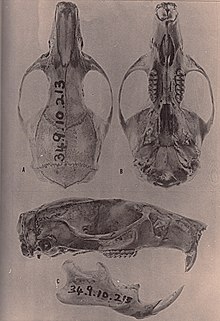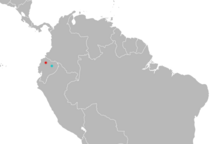| Hammond's rice rat | |
|---|---|

| |
| Skull and mandible[1] | |
| Scientific classification | |
| Domain: | Eukaryota |
| Kingdom: | Animalia |
| Phylum: | Chordata |
| Class: | Mammalia |
| Order: | Rodentia |
| Family: | Cricetidae |
| Subfamily: | Sigmodontinae |
| Genus: | Mindomys |
| Species: | M. hammondi
|
| Binomial name | |
| Mindomys hammondi (Thomas, 1913)
| |

| |
| Distribution of Mindomys: Mindo (type locality) in red; Concepción (dubious second locality) in blue.[3] | |
| Synonyms[Note 1] | |
| |
Mindomys hammondi, also known as Hammond's rice rat[2] or Hammond's oryzomys,[8] is an endangered species of rodent in the tribe Oryzomyini of family Cricetidae. Formerly considered to be related with Nectomys, Sigmodontomys, Megalomys, or Oryzomys, it is now placed in then genus Mindomys, but its relationships remain obscure; some evidence supports a placement near Oecomys or as a basal member of Oryzomyini.
Mindomys hammondi is known only from Ecuador, where it occurs in montane forest; a record from the Amazon basin lowlands is dubious. Reportedly, it lives on the ground and is associated with water; others suggest it lives in trees. A large, long-tailed, and long-whiskered rat, its fur is buff above and abruptly lighter below. The front part of the skull (rostrum) is heavily built.
The species is named after the collector who first found it, Gilbert Hammond. He supplied natural history specimens to Oldfield Thomas and others.[9]
- ^ Ray, 1962, plate XV
- ^ a b Tirira et al., 2008
- ^ Cite error: The named reference
Wea17was invoked but never defined (see the help page). - ^ Thomas, 1913, p. 570
- ^ Hershkovitz, 1948, p. 56
- ^ Steadman and Ray, 1982, p. 4
- ^ Cite error: The named reference
Wea16was invoked but never defined (see the help page). - ^ Musser and Carleton, 2005, p. 1149
- ^ Beolens, Bo; Watkins, Michael; Grayson, Michael (2009). The Eponym Dictionary of Mammals. Baltimore: The Johns Hopkins University Press. p. 175. ISBN 978-0-8018-9304-9. OCLC 270129903.
Cite error: There are <ref group=Note> tags on this page, but the references will not show without a {{reflist|group=Note}} template (see the help page).
